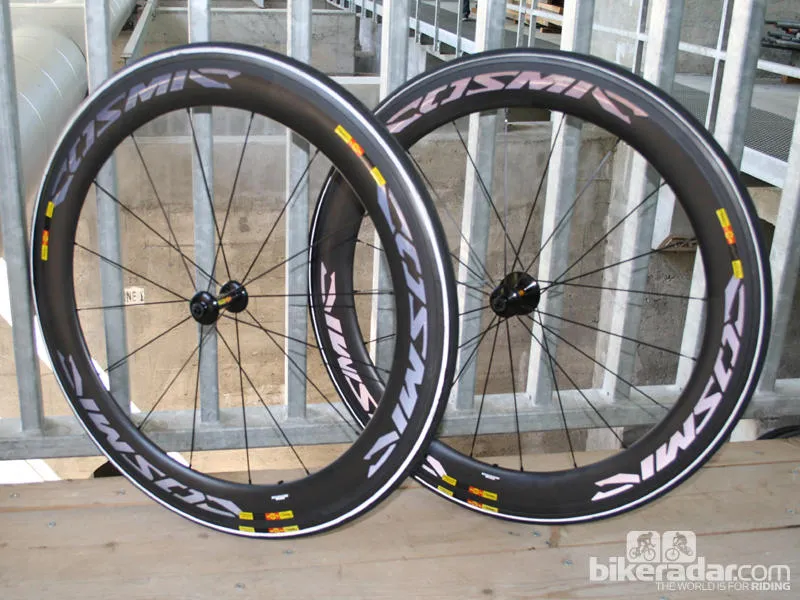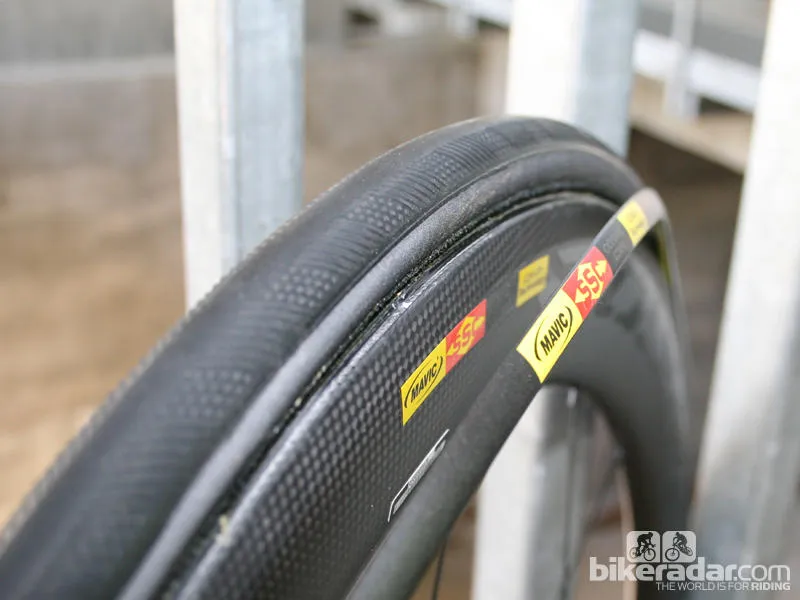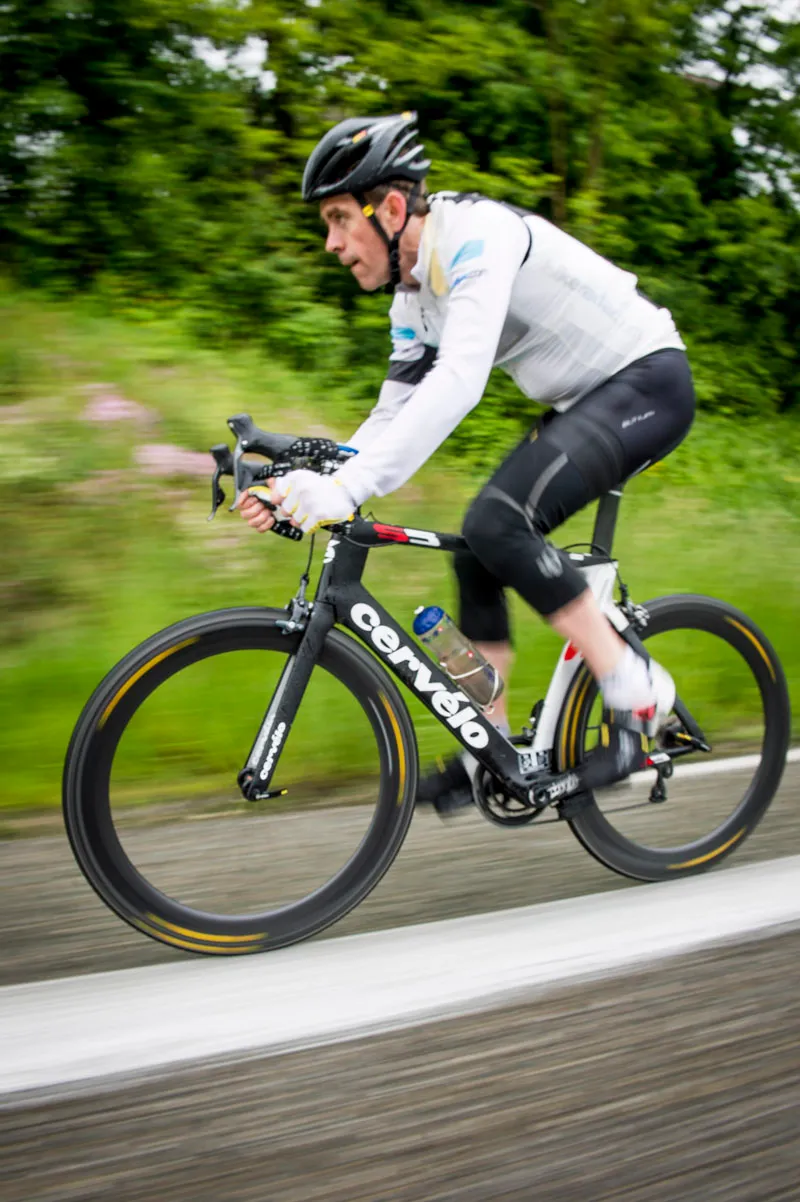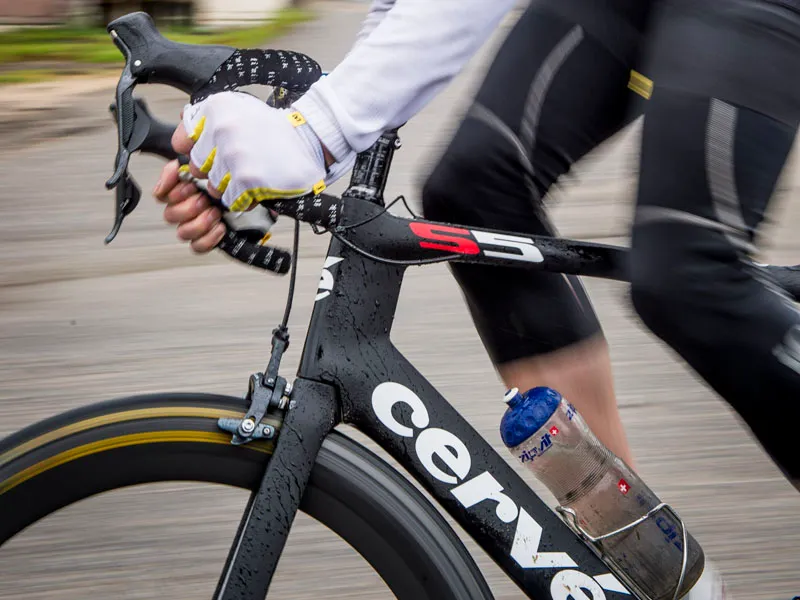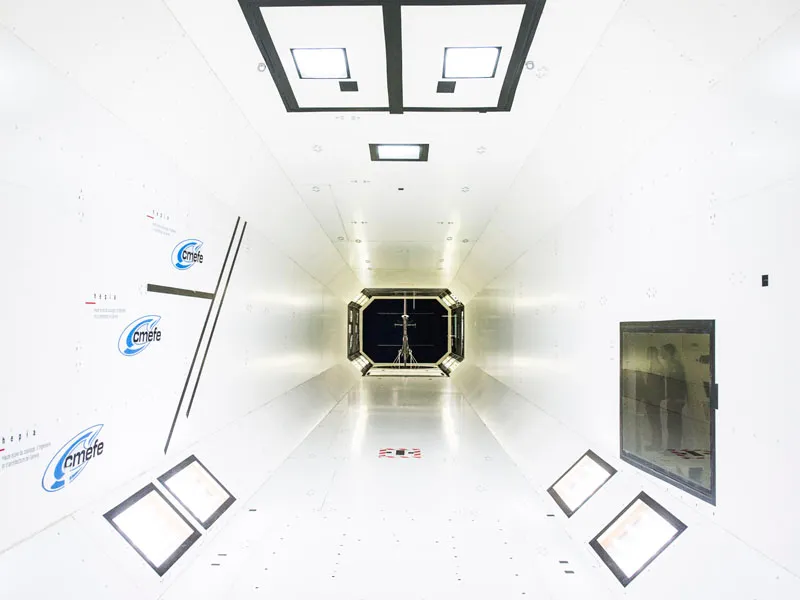The Mavic Cosmic Carbone CXR series of wheels – aimed at road racers, time triallists and triathletes – represents a step forward in aerodynamics for the French manufacturers. We had a chance to test ride a set of CXR 60 Ts, the tubular versions of the 60mm deep wheels that Mavic launched in Geneva recently.
The 75km undulating group ride around Lac du Bourget near Aix-les-Bains, France, was a wet and relatively windless affair – hardly ideal for testing the stability characteristics of the wheels, which we hope to do at a later date. With that in mind, here are our first impressions of Mavic's latest aero wheels.
Ride & handling: Fast, but we need more wind!
Our test rig was a Cervelo S5 with Shimano Dura-Ace Di2, and we were wearing light winter kit with a long sleeve jersey, gilet and knee warmers. We only mention this because it was hard to tell whether the aero benefits of the bike were cancelled out by the bulkier clothing.
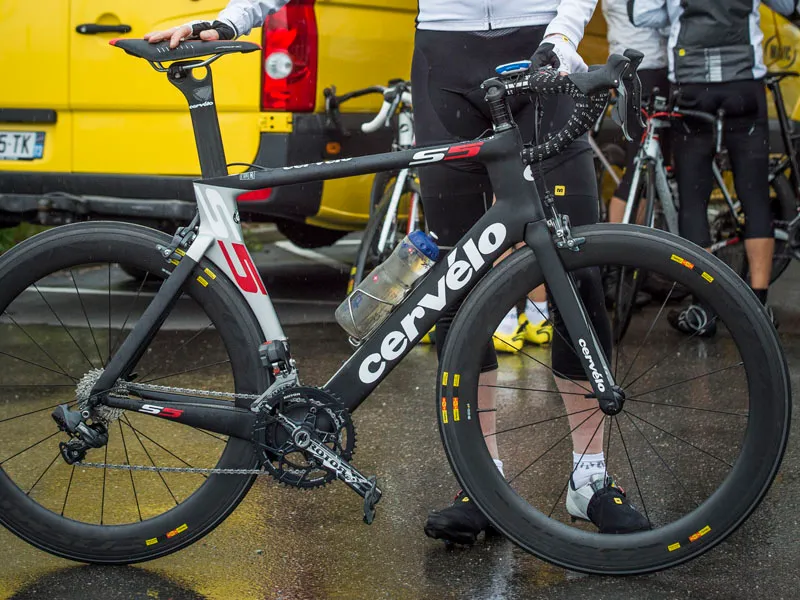
Our Cervelo S5 test rig
Our Mavic CXR 60 test ride started at a sedate pace, led out by top triathlete Frederik Van Lierde. At 19mph (30km/h) in a group with not much wind blowing across us, the wheels felt perfectly manageable and it was easy to maintain that pace. The only incident of note came when five riders crashed on a set of slippery and angled train tracks. We were told this was an improvement on last year, when nine cyclists came down in similar conditions.
We did tackle some short climbs with not-too-steep gradients. Here, the effects of gravity started to come into play and the wheels' claimed weight of 1,600g per pair didn't do them a lot of favours. Aerodynamics are still important when climbing, however, and we didn't feel bogged down in any way.
Where they really shine is on longer descents and flatter sections, where they held their speed very well – a good sign that the aero properties were working as they should. We were most impressed when we put in a solo effort at threshold for a few kilometres on the flat, pleasantly surprised to be bowling along at a sustainable 44-45km/h. It's hard to say how much faster this would have been over a standard wheelset - Mavic's data suggests an improvement of around 0.75N (0.5km/h at 40km/h) over a Kysrium based on drag from the front wheel only. This would be greater (but not double) with a complete wheelset.
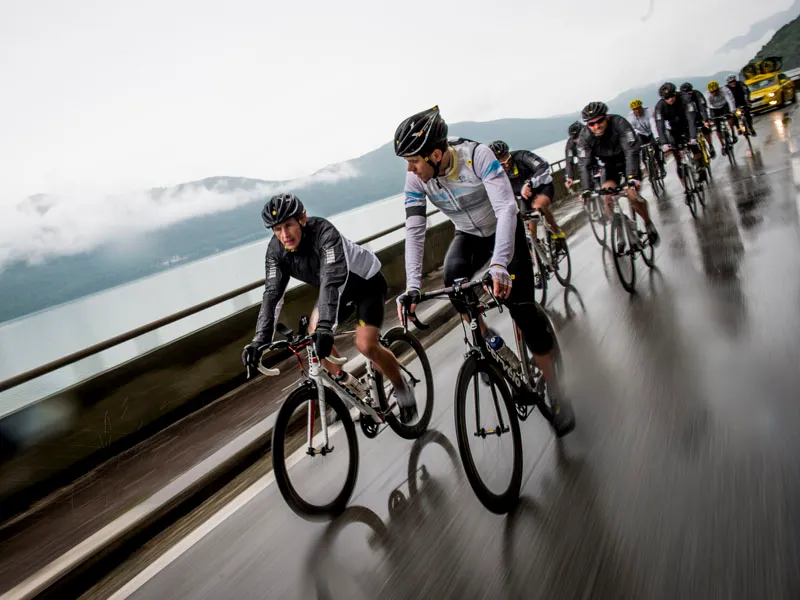
Testing the Mavic CXR 60 Ts around Lac du Bourget, near Aix-les-Bains, France
We weren't able to test the wheels in the wind, unfortunately, and we'd definitely like to do this before making a call on stability. On the plus side, there was little movement when trucks passed us going the opposite way. We've ridden wheels where we were blown across the road by this in otherwise low wind conditions.
We have tested the deeper CXR 80s in the wind, though. We found those to be better than expected in crosswinds – they certainly moved around but they didn't scare us. That said, they wouldn't be our wheel of choice for all conditions.
We were able to test braking with the CXR 60s quite often, and this was surprisingly good. The carbon brake tracks don't have the Mavic Exalith treatment used on the clincher versions, nor do they have the new surface used on the Cosmic Carbone 40s. But when they were combined with Mavic pads (made by Swisstop) we didn't have to perform much rim cleaning and there was no grab from the brakes. Nevertheless, we hope Mavic will improve this aspect with their newer technology in future.
We found the lateral stiffness of the wheels to be lacking a little, and noticed a small amount of rear brake rub when the brakes were close set. It wasn't just in our wheels – we detected it in other riders' too. This is another area for improvement, albeit a small one.
Tyre performance: Aero wins over rolling resistance
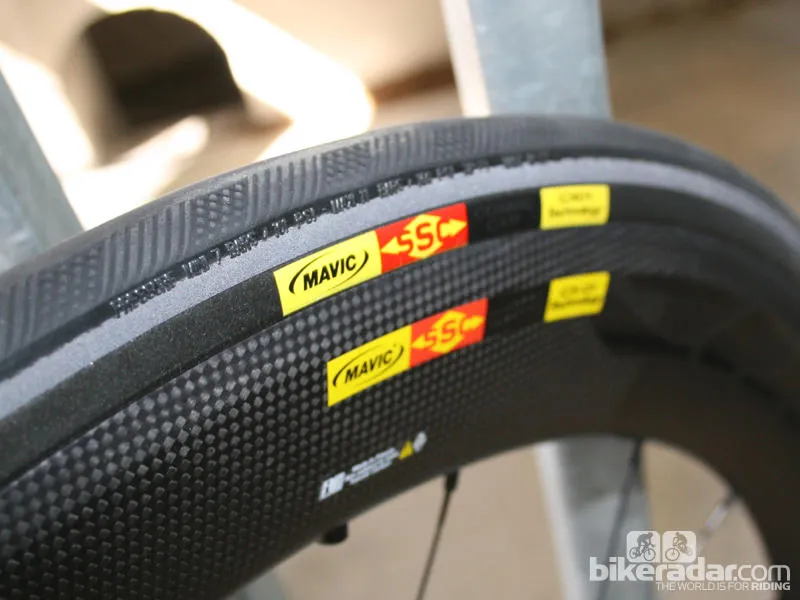
Mavic's Yksion GripLink and PowerLink tyres have a special tread pattern to help reduce drag
Mavic's new aero wheelsets are designed to run with the company's Yksion tyres and CX01 blades for best aero performance, which is why they're dubbed WTS (Wheel Tyre System).
The tyres, blades and rim combine into one shape that's been designed to be more aero at the leading and trailing edges than normal profile tyres. The tyres even incorporate a tread pattern – not for grip but to introduce a small amount of turbulence at the top of the tyre, which supposedly helps keep the air attached over the tyre-rim for longer. That's desirable in order to reduce drag.
Aero properties aside, the Yksion GripLink (front) and PowerLink (rear) tubulars did a decent enough job on the road. We experienced no problems with grip on the wet Tarmac and it would be unfair to blame the tyres for the train track incident.
We didn't feel they had the zing of a faster-rolling set of tubulars, and from what little data we have, the rolling resistance of these tyres isn't that great. They are, however, designed for racing on all road surfaces in all conditions, so grip and feel are of more importance.
We've weighed a set of Yksion GripLink and PowerLink tubulars at 236g apiece; slightly higher than the claimed weight of 230g but there was a little glue residue. They have a claimed carcass TPI (threads per inch) count of 210, which is high, but that doesn't always translate into low rolling resistance. The tyres certainly don't feel that supple.
Materials & construction
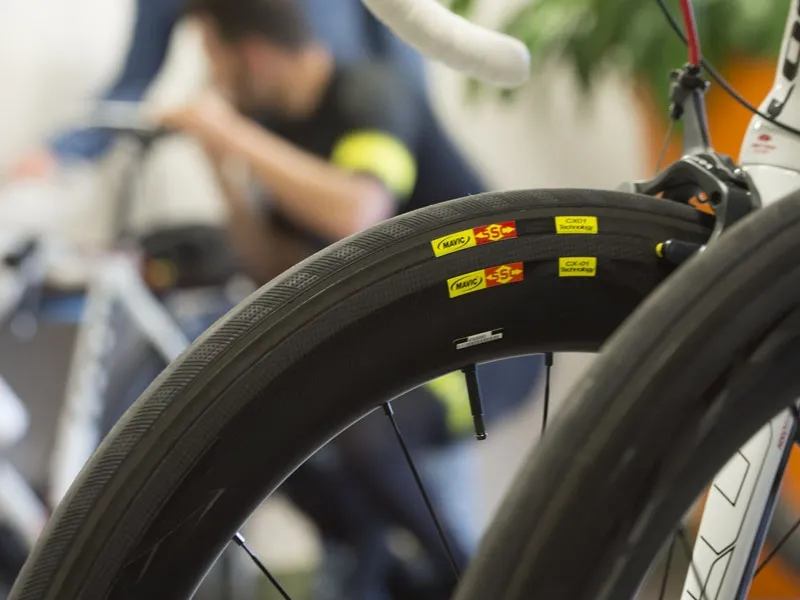
The 60mm deep, 27mm wide rims are made from 3K carbon fibre
The rims on the CXR 60 Ts are constructed from 3K carbon fibre. They're 60mm deep on the front and rear and feature a 27mm-wide rim bed with special grooves for the CX01 blades – make sure your forks and brakes can accommodate this before buying a set, as some setups don't.
As the trend towards wider rims continues, we've no doubt that this will be factored into the design of frames, particularly time trial frames with integrated brakes. If you don't use Yksion tyres then Mavic recommend trying 23mm tubulars to better fit the rim profile.
The rims are non-eyeleted and drilled with 16 holes for front spokes and 20 for the rear. The front wheel is laced radially while the rear uses a two-cross pattern on the driveside and radial on the non-driveside.
Mavic haven't done anything new with their hubs and spokes in the CXR 60 wheelset, despite testing various flange shapes and widths for their aerodynamic properties.
In the end, they opted for the same dimensions as they use on their other wheels, for practicality and stiffness. Given the narrow diameter of the carbon fibre hub shell, we'd be hard pressed to see how this could be improved. The axles and flanges are made from aluminium while the bearings are steel.
The Cosmic Carbone CXR 60 T wheelsets are priced at £2000/€2,200/US$TBC, which includes Yksion tubulars, CX01 blades, quick-releases, CXR-specific brake pads, valve extenders, an adjustment wrench, a manual and a pair of wheelbags. Not a bad deal all up, given the competition.
A positive first impression
We enjoyed our first ride on the Mavic Cosmic Carbone CXR 60 Ts. Their high-speed performance impressed us and we look forward to putting some more time on them (or the clinchers) in windier conditions.
